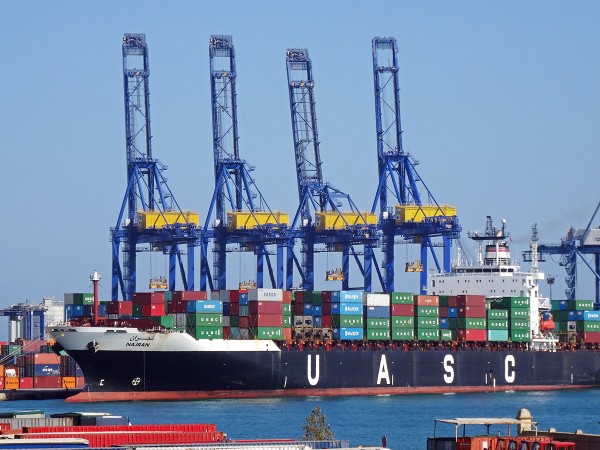 Newspaper headlines this week read that the UK’s balance of trade deficit has widened to £34.8bn, the largest since 2010. And when you exclude services, the trade in goods deficit, at £119.9bn is the largest ever in nominal terms and is also likely to be the largest as a percentage of GDP.
Newspaper headlines this week read that the UK’s balance of trade deficit has widened to £34.8bn, the largest since 2010. And when you exclude services, the trade in goods deficit, at £119.9bn is the largest ever in nominal terms and is also likely to be the largest as a percentage of GDP.
So far so bad. But when you look a little closer, the picture is more mixed. The balance of trade deficit (i.e. on both goods and services) narrowed each quarter of 2014, although the monthly figure did widen in December 2014. In fact the trade in goods deficit increased substantially in December from £9.3bn to £10.2bn.
At first sight the widening of the trade deficit in December might seem surprising, given the dramatic drop in oil prices. Surely, with demand for oil being relatively inelastic, a large cut in oil prices should significantly reduce the expenditure on oil? In fact the reverse happened. The oil deficit in December increased from £598m to £940m. The reason is that oil importing companies have been stockpiling oil while low prices persist. Clearly, this is in anticipation that oil prices will rise again before too long. What we have seen, therefore, is a demand that is elastic in the short run, even though it is relatively inelastic in the medium run.
But the trade deficit is still large. Even when you strip out oil, the deficit in December still rose – from £8.7bn to £9.2bn. There are two main reasons for this deterioration.
The first is a strong pound. The sterling exchange rate index rose by 1.8% in December and a further 0.4% in January. With quantitative easing pushing down the value of the euro and loose monetary policies in China and Australia pushing down the value of their currencies, sterling is set to appreciate further.
The second is continuing weakness in the eurozone and a slowing of growth in some major developing countries, including China. This will continue to dampen the growth in UK exports.
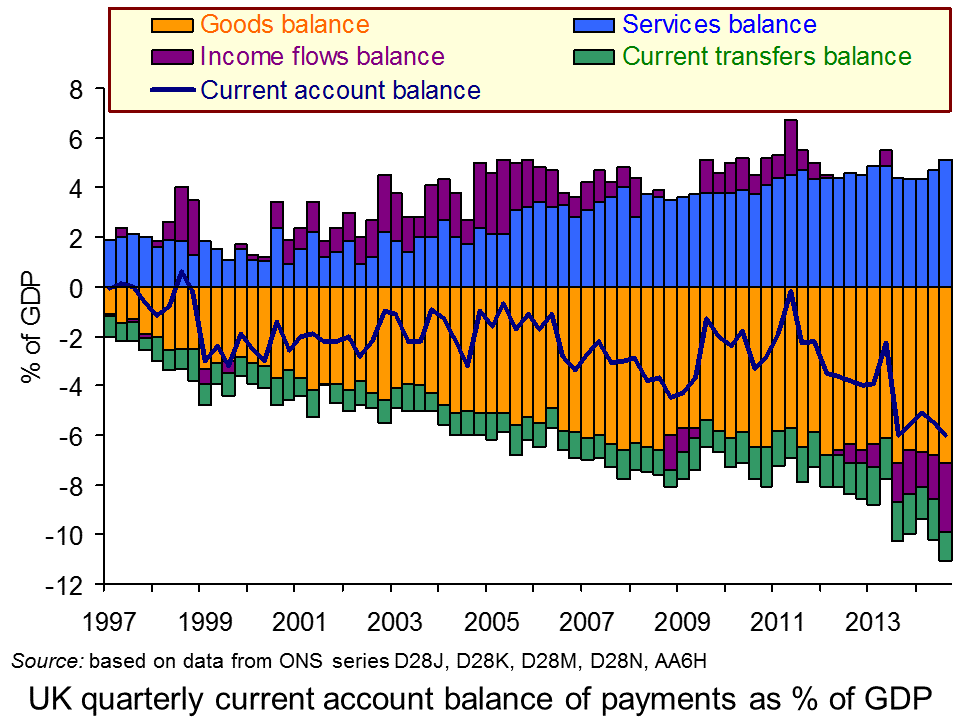 But what of the overall current account? Figures are at present available only up to 2014 Q3, but the picture is bleak (see the chart). As the ONS states:
But what of the overall current account? Figures are at present available only up to 2014 Q3, but the picture is bleak (see the chart). As the ONS states:
The current account deficit widened in Q3 2014, to 6.0% of nominal Gross Domestic Product GDP, representing the joint largest deficit since Office for National Statistics (ONS) records began in 1955.
This deterioration in performance can be partly attributed to the recent weakness in the primary income balance [see]. This also reached a record deficit in Q3 2014 of 2.8% of nominal GDP; a figure that can be primarily attributed to a fall in UK residents’ earnings from investment abroad, and broadly stable foreign resident earnings on their investments in the UK
The primary income account captures income flows into and out of the UK economy, as opposed to current transfers (secondary income) from taxes, grants, etc. The large deficit reflects a decline in the holding by UK residents of foreign assets from 92% of GDP in 2008 to 67% by the end of 2014. This, in turn, reflects the poorer rate of return on many of these assets. By contrast, the holdings of UK assets by foreign residents has increased. They have been earning a higher rate of return on these assets than UK residents have on foreign assets. And so, despite UK interest rates having fallen, as the quote above says, foreign residents’ earnings on their holding of UK assets has remained broadly stable.
Articles
UK trade deficit last year widest since 2010 BBC News (6/2/15)
UK’s trade deficit widens to 2010 high as consumers take advantage of falling oil The Telegraph, Peter Spence (6/2/15)
UK trade deficit widens to four-year high The Guardian, Katie Allen (6/2/15)
UK trade deficit hits four-year high Financial Times, Ferdinando Giugliano (6/2/15)
Data
Balance of Payments ONS (topic link)
Summary: UK Trade, December 2014 ONS (6/2/15)
Current account, income balance and net international investment position ONS (23/1/15)
Pink Book – Tables ONS
Questions
- Distinguish between he current account, the capital account and the financial account of the balance of payments.
- If the overall balance of payments must, by definition, balance, why does it matter if the following are in deficit: (a) trade in goods; (b) the current account; (b) income flows?
- What would cause the balance of trade deficit to narrow?
- Discuss what policies the government could pursue to reduce the size of the current account deficit? Distinguish between demand-side and supply-side policies.
- Why has the sterling exchange rate index been appreciating in recent months?
- What do you think is likely to happen to the sterling exchange rate index in the coming months? Explain.
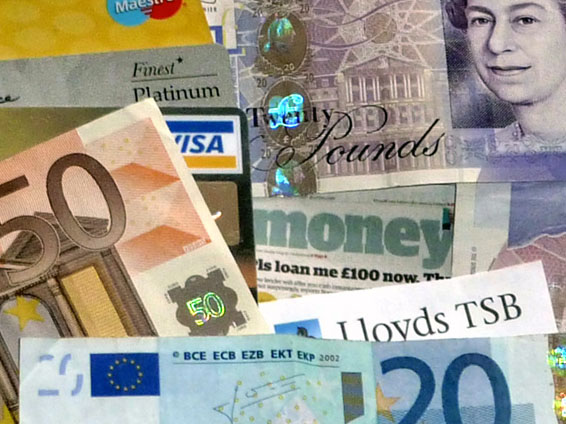 The first link below is to an excellent article by Noriel Roubini, Professor of Economics at New York University’s Stern School of Business. Roubini was one of the few economists to predict the 2008 financial crisis and subsequent recession. In this article he looks at the current problem of substantial deficiency of demand: in other words, where actual output is well below potential output (a negative output gap). It is no wonder, he argues, that in these circumstances central banks around the world are using unconventional monetary policies, such as virtually zero interest rates and quantitative easing (QE).
The first link below is to an excellent article by Noriel Roubini, Professor of Economics at New York University’s Stern School of Business. Roubini was one of the few economists to predict the 2008 financial crisis and subsequent recession. In this article he looks at the current problem of substantial deficiency of demand: in other words, where actual output is well below potential output (a negative output gap). It is no wonder, he argues, that in these circumstances central banks around the world are using unconventional monetary policies, such as virtually zero interest rates and quantitative easing (QE).
He analyses the causes of deficiency of demand, citing banks having to repair their balance sheets, governments seeking to reduce their deficits, attempts by firms to cut costs, effects of previous investment in commodity production and rising inequality.
 The second link is to an article about the prediction by the eminent fund manager, Crispin Odey, that central banks are running out of options and that the problem of over-supply will lead to a global slump and a stock market crash that will be ‘remembered in a hundred years’. Odey, like Roubini, successfully predicted the 2008 financial crisis. Today he argues that the looming ‘down cycle will cause a great deal of damage, precisely because it will happen despite the efforts of central banks to thwart it.’
The second link is to an article about the prediction by the eminent fund manager, Crispin Odey, that central banks are running out of options and that the problem of over-supply will lead to a global slump and a stock market crash that will be ‘remembered in a hundred years’. Odey, like Roubini, successfully predicted the 2008 financial crisis. Today he argues that the looming ‘down cycle will cause a great deal of damage, precisely because it will happen despite the efforts of central banks to thwart it.’
I’m sorry to post this pessimistic blog and you can find other forecasters who argue that QE by the ECB will be just what is needed to stimulate economic growth in the eurozone and allow it to follow the USA and the UK into recovery. That’s the trouble with economic forecasting. Forecasts can vary enormously depending on assumptions about variables, such as future policy measures, consumer and business confidence, and political events that themselves are extremely hard to predict.
Will central banks continue to deploy QE if the global economy does falter? Will governments heed the advice of the IMF and others to ease up on deficit reduction and engage in a substantial programme of infrastructure investment? Who knows?
An Unconventional Truth Project Syndicate, Nouriel Roubini (1/2/15)
UK fund manager predicts stock market plunge during next recession The Guardian, Julia Kollewe (30/1/15)
Questions
- Explain each of the types of unconventional monetary policy identified by Roubini.
- How has a policy of deleveraging by banks affected the impact of quantitative easing on aggregate demand?
- Assume you predict that global economic growth will increase over the next two years. What reasons might you give for your prediction?
- Why have most commodity prices fallen in recent months? (In the second half of 2014, the IMF all-commodity price index fell by 28%.)
- What is likely to be the impact of falling commodity prices on global demand?
- Some neo-liberal economists had predicted that central bank policies ‘would lead to hyperinflation, the US dollar’s collapse, sky-high gold prices, and the eventual demise of fiat currencies at the hands of digital krypto-currency counterparts’. Why, according to Roubini, did the ‘root of their error lie in their confusion of cause and effect’?
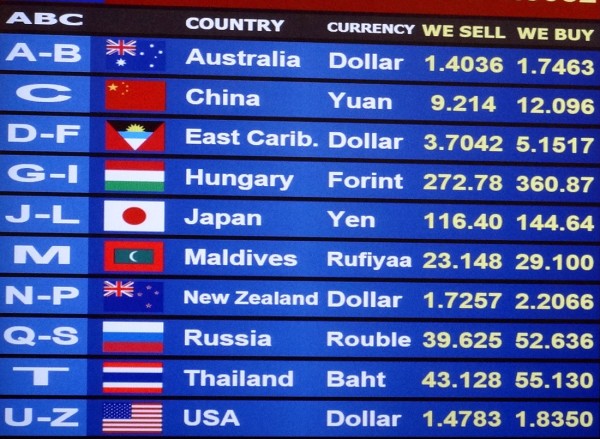 One effect of an expansionary monetary policy is a depreciation of the exchange rate. Take the case of countries using a combination of a reduction in central bank interest rates and quantitative easing (QE). A fall in interest rates will encourage an outflow of finance; and part of the money created through quantitative easing will be used to purchase foreign assets. Both create an increased demand for foreign currencies and drive down the exchange rate.
One effect of an expansionary monetary policy is a depreciation of the exchange rate. Take the case of countries using a combination of a reduction in central bank interest rates and quantitative easing (QE). A fall in interest rates will encourage an outflow of finance; and part of the money created through quantitative easing will be used to purchase foreign assets. Both create an increased demand for foreign currencies and drive down the exchange rate.
The latest case of expansionary monetary policy is that employed by the ECB. After months of promising to ‘do whatever it takes’ and taking various steps towards full QE, the ECB finally announced a large-scale QE programme on 22 January 2015.
 With people increasingly predicting QE and with the ECB reducing interest rates, so the euro depreciated. Between March 2014 and 21 January 2015, the euro depreciated by 20.2% against the dollar and the euro exchange rate index depreciated by 9.7%. With the announced programme of QE being somewhat larger than markets expected, in the week following the announcement the euro fell a further 2.3% against the dollar, and the euro exchange rate index also fell by 2.3%. The euro is now at its lowest level against the US dollar since April 2003 (see chart).
With people increasingly predicting QE and with the ECB reducing interest rates, so the euro depreciated. Between March 2014 and 21 January 2015, the euro depreciated by 20.2% against the dollar and the euro exchange rate index depreciated by 9.7%. With the announced programme of QE being somewhat larger than markets expected, in the week following the announcement the euro fell a further 2.3% against the dollar, and the euro exchange rate index also fell by 2.3%. The euro is now at its lowest level against the US dollar since April 2003 (see chart).
The depreciation of the euro will be welcome news for eurozone exporters. It makes their exports cheaper in foreign currency terms and thus makes their exports more competitive.  Similarly Japanese exporters were helped by the depreciation of the yen following the announcement on 31 October 2014 by the Bank of Japan of an increase in its own QE programme. The yen has depreciated by 7.7% against the dollar since then.
Similarly Japanese exporters were helped by the depreciation of the yen following the announcement on 31 October 2014 by the Bank of Japan of an increase in its own QE programme. The yen has depreciated by 7.7% against the dollar since then.
But every currency cannot depreciate against other currencies simultaneously. With any bilateral exchange rate, the depreciation of one currency represents an appreciation of the other. So just as the euro and yen have depreciated against the dollar, the dollar has appreciated against the euro and yen. This has made US goods less competitive relative to eurozone and Japanese goods.
The danger is that currency wars will result, with monetary policy being used in various countries to achieve competitive depreciations. Already, the Swiss have been forced, on 15 January, to remove the cap with the euro at SF1 – €0.833. Since then the Swiss franc has appreciated by some 15% to around SF1 – €0.96. Will the Swiss now be forced to relax their monetary policy?
The Danish and Canadian central banks have cut their interest rates, hoping to stem an appreciation of their currencies. On 28 January, the Monetary Authority of Singapore sold Singapore dollars to engineer a depreciation. The Singapore dollar duly fell by the most in over four years.
But are these policies simply beggar-my-neighbour policies? Is it a zero-sum game, where the gains to the countries with depreciating currencies are exactly offset by losses to the those with appreciating ones? Or is there a net gain from overall looser monetary policy at a time of sluggish growth? Or is there a net loss from greater currency volatility, which will create greater uncertainty and dampen cross-border investment? The following article explore the issues.
Articles
Massive Devaluation of the Euro Seeking Alpha, Sagar Joshi (26/1/15)
Devaluation and discord as the world’s currencies quietly go to war The Observer (25/1/15)
Why is dollar strong vs. 18 trillion of USA’s debt? Pravda, Lyuba Lulko (26/1/15)
Central Bankers Ramp Up Currency Wars Wall Street Journal, Anjani Trivedi, Josie Cox and Carolyn Cui (28/1/15)
The Raging Currency Wars Across Europe The Market Oracle, Gary_Dorsch (29/1/15)
Why ECB action is likely to stoke global currency wars Financial Times, Ralph Atkins (22/1/15)
Euro slides as ECB launches QE Financial Times (22/1/15)
Will Australia join the Currency Wars? The Daily Reckoning, Australia, Greg Canavan (23/1/15)
Australia’s central bank cuts rates to record low; currency plunges and stocks spike The Telegraph (3/2/15)
Singapore loosens monetary policy Financial Times, Jeremy Grant (28/1/15)
Currency Wars Have a Nuclear Option Bloomberg, Mark Gilbert (12/2/15)
Questions
- Explain how quantitative easing results in depreciation. What determines the size of the depreciation?
- How is the USA likely to react to an appreciation of the dollar?
- In the UK, who will benefit and who will lose from the depreciation of the euro?
- What are the global benefits and costs of a round of competitive depreciations?
- How does the size of the financial account of the balance of payments affect the size of a depreciation resulting from QE?
- What determines a country’s exchange-rate elasticity of demand for exports? How does this elasticity of demand affect the size of changes in the current account of the balance of payments following a depreciation?
- Might depreciation of their currencies reduce countries’ commitment to achieving structural reforms? Or might it ‘buy them time’ to allow them to introduce such reforms in a more carefully planned way and for such reforms to take effect? Discuss.
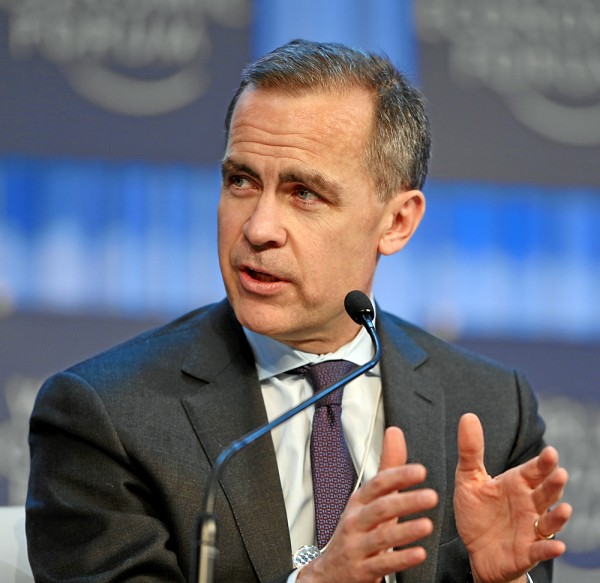 In a speech in Dublin on 28 January 2015, titled ‘Fortune favours the bold‘, Mark Carney, the Governor of the Bank of England, compared the UK economy to that of the 19-nation eurozone. While he welcomed the ECB’s recently announced quantitative easing programme, he argued that the current construction of the eurozone is unfinished and still has two fundamental weaknesses that have not been addressed.
In a speech in Dublin on 28 January 2015, titled ‘Fortune favours the bold‘, Mark Carney, the Governor of the Bank of England, compared the UK economy to that of the 19-nation eurozone. While he welcomed the ECB’s recently announced quantitative easing programme, he argued that the current construction of the eurozone is unfinished and still has two fundamental weaknesses that have not been addressed.
The first is the fragmented nature of banking:
With limited cross-border banking in the euro area, savings don’t flow to potential investments. Euro-area corporates’ cash balances have risen to the tune of €420 billion, or 3% of GDP, since the crisis, for example. Modest cross-border equity flows mean inadequate risk sharing.
The second is the lack of an integrated fiscal policy.
For complete solutions to both current and potential future problems, the sharing of fiscal risks is required.
It is no coincidence that effective currency unions tend to have centralised fiscal authorities whose spending is a sizeable share of GDP – averaging over a quarter of GDP for advanced countries outside the euro area.
… If the eurozone were a country, fiscal policy would be substantially more supportive. However, it is tighter than in the UK, even though Europe still lacks other effective risk sharing mechanisms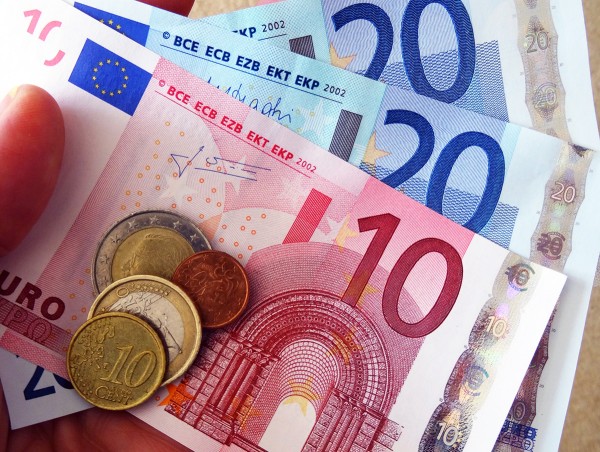 and is relatively inflexible. A more constructive fiscal policy would help recycle surplus private savings and mitigate the tail risk of stagnation. It would also bridge the drag from structural reforms on nominal spending and would be consistent with the longer term direction of travel towards greater integration.
and is relatively inflexible. A more constructive fiscal policy would help recycle surplus private savings and mitigate the tail risk of stagnation. It would also bridge the drag from structural reforms on nominal spending and would be consistent with the longer term direction of travel towards greater integration.
But fiscal integration requires a political will to transfer fiscal surpluses from the stronger countries, such as Germany, to the weaker countries, such as those in southern Europe.
Overall, the financial and fiscal position in the eurozone is strong:
Gross general government debt in the euro area is roughly the same as in the UK and below the average of advanced economies. The weighted average yield on 10-year euro area sovereign debt is around 1%, compared to 1½% in the UK. And yet, the euro area’s fiscal deficit is half that in the UK. Its structural deficit, according to the IMF, is less than one third as large.
But, unlike the UK, where, despite the rhetoric of austerity, automatic fiscal stabilisers have been allowed to work and the government has accepted a much slower than planned reduction in the deficit, in the eurozone fiscal policy remains tight. Yet unemployment, at 11½%, is twice the rate in the UK and economic growth, at around 0.7% is only one-quarter of that in the UK.
Without a eurozone-wide fiscal policy the problem of slow growth is likely to persist for some time. Monetary policy in the form of QE will help and structural reforms will help to stimulate potential output and long-term growth, but these policies could be much more effective if backed up by fiscal policy.
Whether they will be any time soon is a political question.
Speech
Fortune favours the bold Bank of England. Mark Carney (29/1/15)
Articles
Bank of England’s Carney urges Europe to take plunge on fiscal union Reuters, Padraic Halpin (28/1/15)
Bank Of England’s Mark Carney Attacks ‘Timid’ Eurozone Recovery Attempts Huffington Post, Jack Sommers (29/1/15)
BoE’s Mark Carney calls for common eurozone fiscal policies Financial Times, Ferdinando Giugliano (28/1/15)
Carney attacks German austerity BBC News, Robert Peston (28/1/15)
Bank of England governor attacks eurozone austerity The Guardian, Larry Elliott (28/1/15)
Questions
- Compare the financial and fiscal positions of the UK and the eurozone.
- In what way is there a ‘debt trap’ in the eurozone?
- What did Mark Carney mean when he said, ‘Cross-border risk-sharing through the financial system has slid backwards.’?
- What options are there for the eurozone sharing fiscal risks?
- What would a ‘more constructive’ fiscal policy, as advocated by Mark Carney, look like?
- How do the fiscal policies of other currency unions, such as the UK (union of the four nations of the UK) or the USA (union of the 50 states) or Canada (union of the 10 provinces and three territories), differ from that of the eurozone?
 After Syriza’s dramatic victory in the Greek election, it is now seeking to pursue its manifesto promises of renegotiating the terms of Greece’s bailout and bringing an end to austerity policies.
After Syriza’s dramatic victory in the Greek election, it is now seeking to pursue its manifesto promises of renegotiating the terms of Greece’s bailout and bringing an end to austerity policies.
The bailout of €240bn largely involved debt restructuring to give Greeks more time to pay. A ‘haircut’ (reduction) on privately held bonds, estimated to be somewhere between €50bn and €110bn, was more than offset by an increase of €130bn in loans granted by official creditors.
The terms of the bailout negotiated with the ‘Troika’ of the EU Commission, the ECB and the IMF, had forced the previous Greek government to make substantial fiscal adjustments. These have included large-scale cuts in government expenditure (including public-sector wages), increases in taxes, charges and fares, and selling state assets through an extensive programme of privatisation.
Although Greece is now regarded as having achieved a structural budget surplus (a surplus when the economy is operating at potential output: i.e. with a zero output gap),  the austerity policies and a decline in inward investment have dampened the economy so much that, until last year, the actual budget deficit and public-sector debt continued to rise as tax revenues plummeted.
the austerity policies and a decline in inward investment have dampened the economy so much that, until last year, the actual budget deficit and public-sector debt continued to rise as tax revenues plummeted.
Since 2007, GDP has fallen by nearly 27% and the unemployment rate is around 26%. The fall in GDP has made the achievement of a reduction in the debt/GDP ratio that much harder. General government debt has risen from 103% of GDP in 2007 to 176% in 2014, and the budget deficit, although having peaked at 12.2% of GDP in 2013, has only been brought down through huge cuts.
As a report to the European Parliament from the Economic Governance Support Unit argues on page 27:
With less front-loaded fiscal adjustment, the EU-IMF financing envelope for Greece would have needed to expand, in what is already the largest financial assistance programme in percent of GDP in recent global history. On the other hand, a less rapid fiscal adjustment may have helped to preserve some of the productive capacity that, in the course of the adjustment, was destroyed.
The new government, although pledging not to default on debt, is insistent on renegotiating the debt and wants to achieve a high level of rescheduling and debt forgiveness. As the new Prime Minister, Alexis Tsipras, says:
On existing loans, we demand repayment terms that do not cause recession and do not push the people to more despair and poverty. We are not asking for new loans; we cannot keep adding debt to the mountain.
But, just as the Greek government is insistent on renegotiating its debt, so the German government and others in the EU are insisting that Greece sticks to the terms of the bailout and carries on with its current programme of debt reduction. Another haircut, they maintain, is out of the question.
We must wait to see how the negotiations play out. We are in the realms of game theory with various possible threats and promises on either side. It will be interesting to how these threats and promises are deployed.
New Leader in Greece Now Faces Creditors New York Times, Liz Alderman (26/1/15)
Syriza’s historic win puts Greece on collision course with Europe The Guardian, Ian Traynor and Helena Smith (26/1/15)
Greece Q&A: what now for Syriza and EU austerity? The Guardian, Phillip Inman (26/1/15)
Greek elections: Syriza gives eurozone economic headache BBC News, Prof Dimitri Mardas (26/1/15)
How a Syriza government would approach the eurozone The Telegraph, Andrew Lilico (19/1/15)
Australian economists urge Greek debt forgiveness as Syriza election win looks likely ABC News, Michael Janda (26/1/15)
Will Syriza win rock the global economy? CBS News, Nick Barnets (26/1/15)
Syriza should ignore calls to be responsible Irish Times. Paul Krugman (27/1/15)
Syriza Victory in Greek Election Roils European Debate Over Austerity Wall Street Journal, Marcus Walker (25/1/14)
Greece markets hit by debt default fears BBC News (28/1/15)
Why Europe Will Cave to Greece Bloomberg, Clive Crook (29/1/15)
Greece and the euro: Take the money and run The Economist, Buttonwood (28/1/15)
Tanking markets send dire warning to Greece’s new government Fortune, Geoffrey Smith (28/1/15)
The biggest debt write-offs in the history of the world The Telegraph, Mehreen Khan (2/2/15)
Questions
- Why has Greek debt continued to rise despite extremely tight fiscal policy?
- How is the structural deficit defined? What difficulties arise in trying to measure its size?
- Would there have been any way of substantially reducing the Greek budget deficit without driving Greece into a deep recession?
- What are the arguments for and against cancelling a large proportion of Greek debt? Is there a moral hazard involved here?
- Will the recently announced ECB quantitative easing programme help to reduce Greece’s debt?
- Are negotiations about debt forgiveness a zero sum game? Explain.
- What are the likely impacts of the Syriza victory on the global economy?
 Newspaper headlines this week read that the UK’s balance of trade deficit has widened to £34.8bn, the largest since 2010. And when you exclude services, the trade in goods deficit, at £119.9bn is the largest ever in nominal terms and is also likely to be the largest as a percentage of GDP.
Newspaper headlines this week read that the UK’s balance of trade deficit has widened to £34.8bn, the largest since 2010. And when you exclude services, the trade in goods deficit, at £119.9bn is the largest ever in nominal terms and is also likely to be the largest as a percentage of GDP. But what of the overall current account? Figures are at present available only up to 2014 Q3, but the picture is bleak (see the chart). As the ONS states:
But what of the overall current account? Figures are at present available only up to 2014 Q3, but the picture is bleak (see the chart). As the ONS states:







